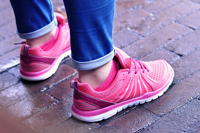 Exercise walking is fun and provides numerous health benefits, but like all exercise, it requires the right equipment. Wear the wrong shoes, and you will end up with sore feet and maybe even an injury. Take your time and invest in the right shoes for your feet and needs.
Exercise walking is fun and provides numerous health benefits, but like all exercise, it requires the right equipment. Wear the wrong shoes, and you will end up with sore feet and maybe even an injury. Take your time and invest in the right shoes for your feet and needs.
Advantages of the Right Walking Shoes
Before you buy walking shoes, examine them and try them on. Look for stability, flexibility and comfort as you prepare for safe workouts. The right shoes give you balance and correct your foot’s natural inward roll (pronation) or outward roll (supination). They also help you maintain proper posture and protect your spine, back and muscles.
Four Main Components of a Good Walking Shoe
There are four main components of quality walking shoes. Examine each part before you make any purchases.
- Heel counter – The area of the shoe under your Achilles tendon should be snug and cup the back of your heel to prevent pronation or supination.
- Midsole – The area between the shoe’s tread and its upper should provide cushioning, support and flexibility. This component is the most important one.
- Insole – The area of the shoe where your foot’s sole comes in contact with the shoe should be contoured to match your foot. It reduces shear forces and provides shock absorption.
- Toe box – The area surrounding your toes should be roomy enough for them to move freely and wiggle and bend without restriction but not too roomy or your foot will shift and feel uncomfortable. Ideally, select shoes with a toe box of at least one-half to one full thumb’s width between your longest toe and the end of the shoe.
How to Try On Walking Shoes
After you find a pair of shoes you like, try them on. Make sure they fit right and feel comfortable.
First, ask the salesperson to measure the dimensions of both feet. To get an accurate reading, stand up because your feet expand when they bear weight. Visit the store at the end of the day, too, as your feet swell during the day.
Remember to wear regular socks and try on both shoes. Lace them completely and stand up and walk around to make sure they fit your foot properly and feel comfortable.
Never buy walking shoes that are too tight. Almost all shoes require a breaking in period, but shoes that are too tight won’t get bigger. However, if you need arch supports or orthotics, feel free to wear those supplements as you obtain the best fit.





